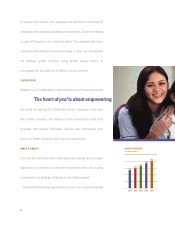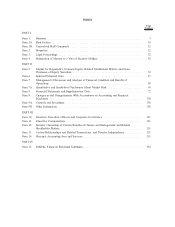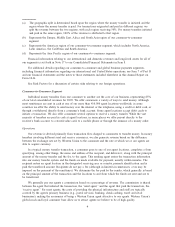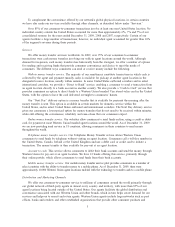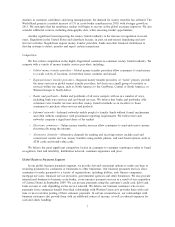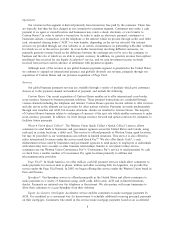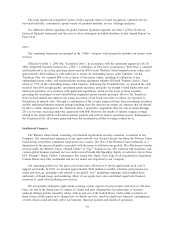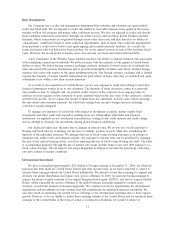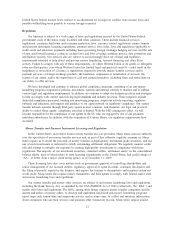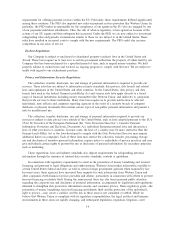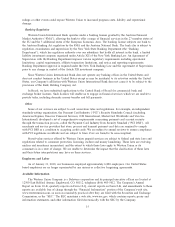Western Union 2009 Annual Report Download - page 20
Download and view the complete annual report
Please find page 20 of the 2009 Western Union annual report below. You can navigate through the pages in the report by either clicking on the pages listed below, or by using the keyword search tool below to find specific information within the annual report.services. Many of our agents have multiple locations. Our agents know the markets they serve and work with
our management to develop business plans for their markets. Many of our agents contribute financial
resources, or otherwise support, our efforts to market the business. Many agents operate in locations that are
convenient for our consumers and are open outside of traditional banking hours, for example on nights and
weekends. Our top 40 agents globally have been with us an average of approximately 13 years, and in 2009,
these long-standing agents were involved in transactions that generated more than 60% of our
consumer-to-consumer revenue.
We provide our third-party agents with our multi-currency, real-time money transfer processing systems
used to originate and pay money transfers. Over the last several years, we have emphasized the development
of our receive network around the world to optimize send and receive corridors. Our systems and processes
enable our agents to pay money transfers in more than 120 currencies worldwide. Many of our agents can pay
in multiple currencies at a single location. Our agents provide the physical infrastructure and staff required to
complete the transfers. Western Union provides central operating functions such as transaction processing,
settlement, marketing support and customer relationship management to our agents.
Some of our agents outside the United States manage subagents. We refer to these agents as superagents.
As of December 31, 2009, we had approximately 800 superagents located throughout the world. Although our
subagents are under contract with these superagents (and not with Western Union directly), the subagent
locations typically have access to the same technology and services that our other agent locations do. On
November 1, 2009, the Payment Services Directive (“PSD”) became effective. Under the PSD, the licensing
and other legal requirements for offering money transfer and other payment services within European Union
(“EU”) countries were harmonized, allowing us to expand the types of businesses that can offer money
transfer services in certain countries, which further allows us to develop our distribution network. In
anticipation of the PSD, we acquired the money transfer business of European-based FEXCO, which helped
provide an initial operating infrastructure for the PSD and allowed us to take on services and operations
previously performed by this superagent in several key European countries.
Our international agents often customize services as appropriate for their geographic markets. In some
markets, individual agents are independently offering specific services such as stored-value card payout
options and Direct to Bank service. Our marketing benefits from feedback from our agents and consumers,
and in many of our markets, our agents fund their own marketing activities.
A primary component of our marketing strategy is our global loyalty program, which is available in a
growing number of countries. We launched our Western Union Gold Card, the principal vehicle of the
program, in the United States in 2002. As of December 31, 2009, the Gold Card program was available in 78
countries and had approximately 13 million active cards, an increase in the number of active cards of 20%
from December 31, 2008. The Gold Card offers consumers faster service at the point-of-sale and other
benefits which, depending on the country, could include service fee reductions on future Western Union
branded transactions, discounts at retailers or a rechargeable prepaid phone card embedded within the Gold
Card. Overall, Gold Card consumers initiate more transactions and have a higher rate of retention than non-
carded consumers. Approximately one-third of Western Union branded consumer-to-consumer transactions are
initiated using a Gold Card. The global Gold Card program is one component of our consumer relationship
management strategy designed to support and enhance long-term relationships with our consumers. Consumer
databases supplement these efforts by providing insight on consumer preferences so that we can selectively
target consumer communications and marketing. We have begun offering reloadable debit Gold Cards to our
loyalty card holders in the United States.
Industry Trends
Over the last several years, except for 2009, the cross-border money transfer industry has experienced
growth. Trends in the cross-border money transfer business tend to correlate to migration trends, global
economic opportunity and related employment rates worldwide. The top four inbound remittance countries in
the world are India, China, Mexico and the Philippines, and cumulatively receive an estimated $136 billion
annually according to The World Bank’s November 2009 report. Due to the weak global economy, including
6


